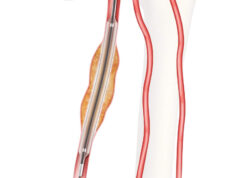NOTE: This video is ONLY available to watch in selected countries and geographies
[xyz-ihs snippet=”vid-01″]
Andrew Holden (Auckland, New Zealand), Alexandros Mallios (Paris, France), Robert Lookstein (New York, USA) and Tobias Steinke (Dusseldorf, Germany) talk to BLearning Peripheral about the 12-month results of the IN.PACT AV Access randomised controlled trial (RCT) which compared drug-coated balloon (DCB) angioplasty to plain balloon angioplasty.
Holden, who presented the 12-month primary patency data for the first time at LINC 2020 (Leipzig Interventional Course; 28–31 January, Leipzig, Germany), explains that the data showed a “highly significant difference in patency” in the paclitaxel DCB arm (63.8%) when compared with the plain balloon arm (43.6%). He also highlights other key data including a 35.4% reduction in the number of reinterventions in the DCB group, which he notes “really resonates with clinicians as well as patients”.
Mallios notes that the six-month data was not only sustainable but improved and claims that another important point is that, regarding the risk of mortality, “apparently there is no evidence supporting this risk for arteriovenous access”. He discusses the clinical importance of the data which he believes is “very reassuring” and provides a “better quality of life for the patient”.
Lookstein for his part discusses the Economic Impact Model of the German and American healthcare systems which he says provided “a very telling argument” that the technology should be used in the “broadest population possible”. He goes on to look at how these “impressive” datasets, including both the 12-month data and the Economic Impact Model—which showed a DCB cost benefit—have led him to think “even more about using DCBs in AV access patients”.
Finally, Steinke gives his view on the 12-month IN.PACT AV Access data which he says was “really impressive”, noting that this was the first time that “significant results” were seen over this length of observation.
This video is sponsored by Medtronic













